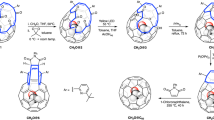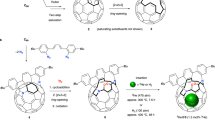Abstract
Cubane1(C8H8) and fullerene2(C60) are famous cage molecules with shapes of platonic or archimedean solids. Their remarkable chemical and solid-state properties have induced great scientific interest3,4,5. Both materials form polymorphic crystals of molecules with variable orientational ordering6,7,8,9. The idea of intercalating fullerene with cubane was raised several years ago10 but no attempts at preparation have been reported. Here we show that C60 and similarly C70 form high-symmetry molecular crystals with cubane owing to topological molecular recognition between the convex surface of fullerenes and the concave cubane. Static cubane occupies the octahedral voids of the face-centred-cubic structures and acts as a bearing between the rotating fullerene molecules. The smooth contact of the rotor and stator molecules decreases significantly the temperature of orientational ordering. These materials have great topochemical importance: at elevated temperatures they transform to high-stability covalent derivatives although preserving their crystalline appearance. The size-dependent molecular recognition promises selective formation of related structures with higher fullerenes and/or substituted cubanes.
This is a preview of subscription content, access via your institution
Access options
Subscribe to this journal
Receive 12 print issues and online access
$259.00 per year
only $21.58 per issue
Buy this article
- Purchase on SpringerLink
- Instant access to full article PDF
Prices may be subject to local taxes which are calculated during checkout



Similar content being viewed by others
References
Eaton, P. E. & Cole, T. W. Jr. Cubane. J. Am. Chem. Soc. 86, 3157–3158 (1964).
Kroto, H. W., Heath, J. R., O’Brien, S. C., Curl, R. F. & Smalley, R. E. C60: Buckminsterfullerene. Nature 318, 162–163 (1985).
Griffin, G. W. & Marchand, A. P. Synthesis and chemistry of cubanes. Chem. Rev. 89, 997–1010 (1989).
Eaton, P. E. Cubanes: starting materials for the chemistry of the 1990s and the new century. Angew. Chem. Int. Edn Engl. 31, 1421–1436 (1992).
Dresselhaus, M. S., Dresselhaus, G. & Eklund, P. C. Science of Fullerenes and Carbon Nanotubes (Academic, San Diego, 1996).
Heiney, P. A. et al. Orientational ordering transition in solid C60 . Phys. Rev. Lett. 66, 2911–2914 (1991).
David, W. I. F., Ibberson, R. M., Dennis, T. J. S., Hare, J. P. & Prassides, K. Structural phase-transitions in the fullerene C60 . Europhys. Lett. 18, 219–225 (1992).
Dalterio, R. A. & Owens, F. J. Raman scattering for high temperature phase transition in solid cubane. Solid State Commun. 67, 673–676 (1988).
White, M. A. et al. Orientational disorder in solid cubane: a thermodynamic and13C NMR study. J. Phys. Chem. 96, 421–425 (1992).
Yildirim, T., Gehring, P. M., Neumann, D. A., Eaton, P. E. & Emrick, T. Unusual structure, phase transition, and dynamics of solid cubane. Phys. Rev. Lett. 78, 4938–4941 (1997).
Murphy, D. W. et al. Synthesis and characterization of alkali metal fullerides: AxC60 . J. Phys. Chem. Solids 53, 1321–1332 (1992).
Konarev, D. V. & Lyubovskaya, R. N. Donor-acceptor complexes and radical ionic salts based on fullerenes. Russ. Chem. Rev. 68, 19–38 (1999).
Fleischer, E. B. X-ray structure determination of cubane. J. Am. Chem. Soc. 86, 3889–3890 (1964).
Vaughan, G. B. et al. Orientational disorder in solvent-free solid C70 . Science 254, 1350–1353 (1991).
Almairac, R., Tranqui, D., Lauriat, J. P., Lapasset, J. & Moret, J. Evidence of phase transitions in C84 . Solid State Commun. 106, 437–440 (1998).
Martin, H. -D., Urbanek, T., Pföhler, P. & Walsh, R. The pyrolysis of cubane; an example of a thermally induced hot molecule reaction. J. Chem. Soc. Chem. Commun. 964–965 (1985).
Hassenrück, K., Martin, H. -D. & Walsh, R. Consequences of strain in (CH)8 hydrocarbons. Chem. Rev. 89, 1125–1148 (1989).
Acknowledgements
This work was supported by the grants of OTKA, The Hungarian Scientific Research Fund.
Author information
Authors and Affiliations
Corresponding author
Ethics declarations
Competing interests
The authors declare no competing financial interests.
Supplementary information
Supplementary Information
Supplementary summaries and figures S1 - S5 (PDF 718 kb)
Rights and permissions
About this article
Cite this article
Pekker, S., Kováts, É., Oszlányi, G. et al. Rotor–stator molecular crystals of fullerenes with cubane. Nature Mater 4, 764–767 (2005). https://doi.org/10.1038/nmat1468
Received:
Accepted:
Published:
Issue date:
DOI: https://doi.org/10.1038/nmat1468
This article is cited by
-
The Relevance of Glutathione Reductase Inhibition by Fluoxetine to Human Health and Disease: Insights Derived from a Combined Kinetic and Docking Study
The Protein Journal (2019)
-
Ratchet-free solid-state inertial rotation of a guest ball in a tight tubular host
Nature Communications (2018)
-
Dynamic molecular crystals with switchable physical properties
Nature Chemistry (2016)
-
A multistep single-crystal-to-single-crystal bromodiacetylene dimerization
Nature Chemistry (2013)



